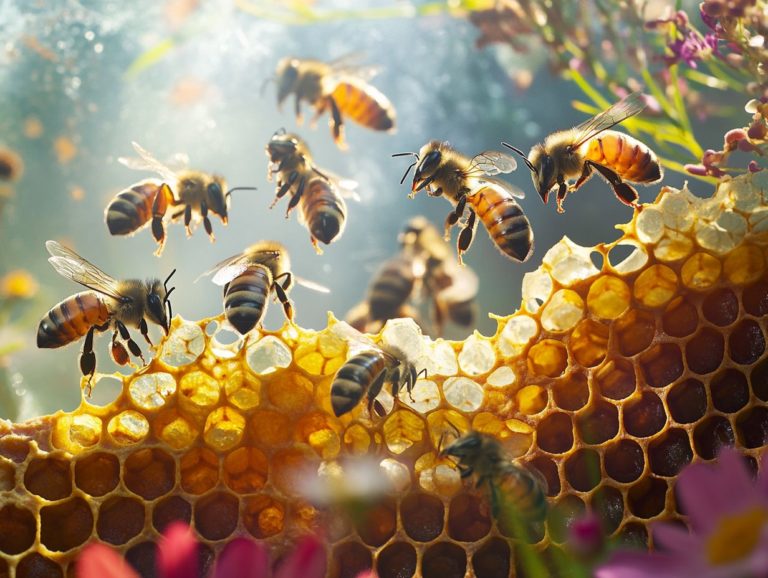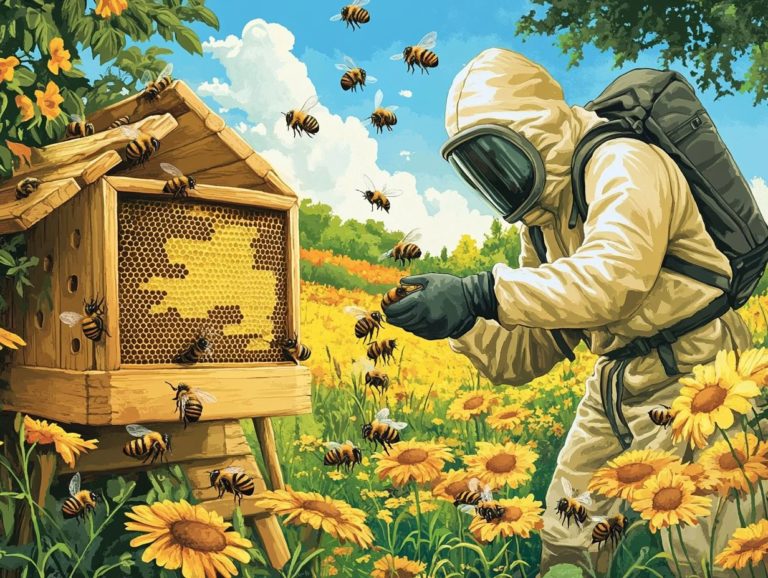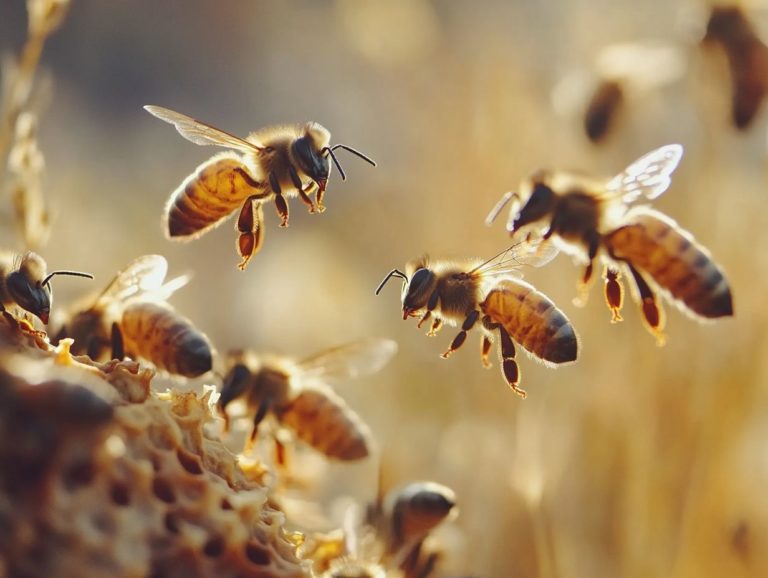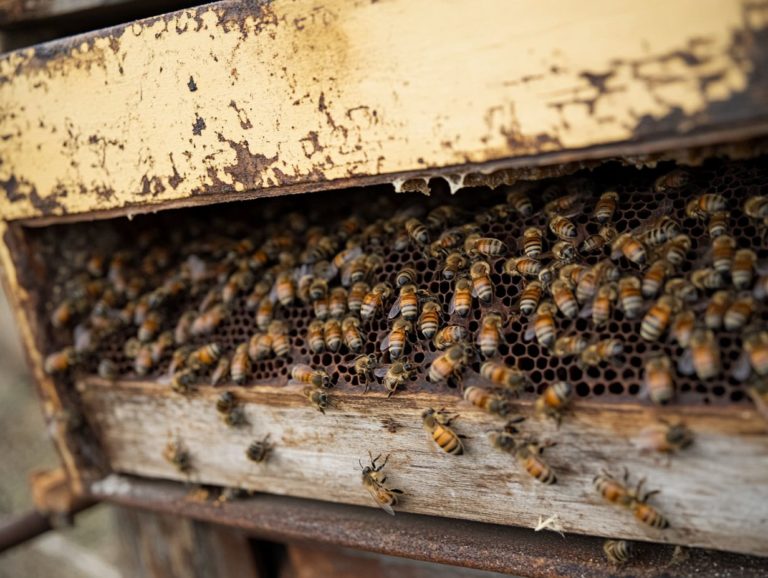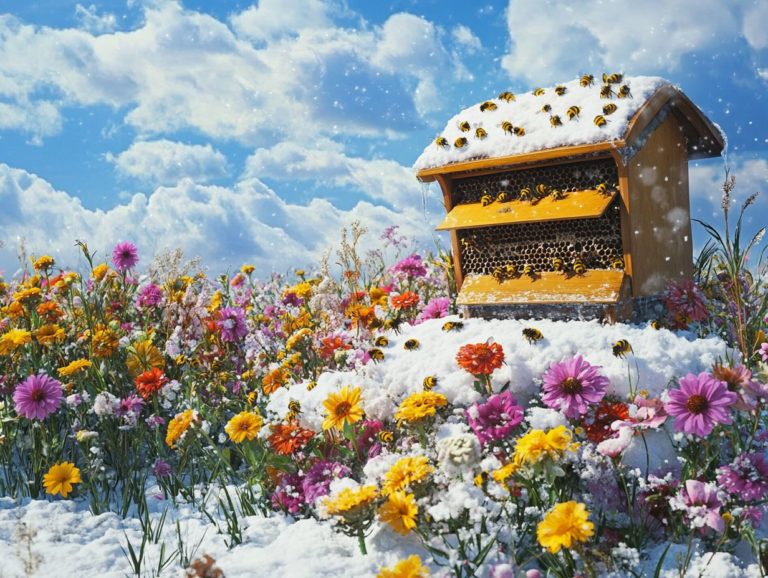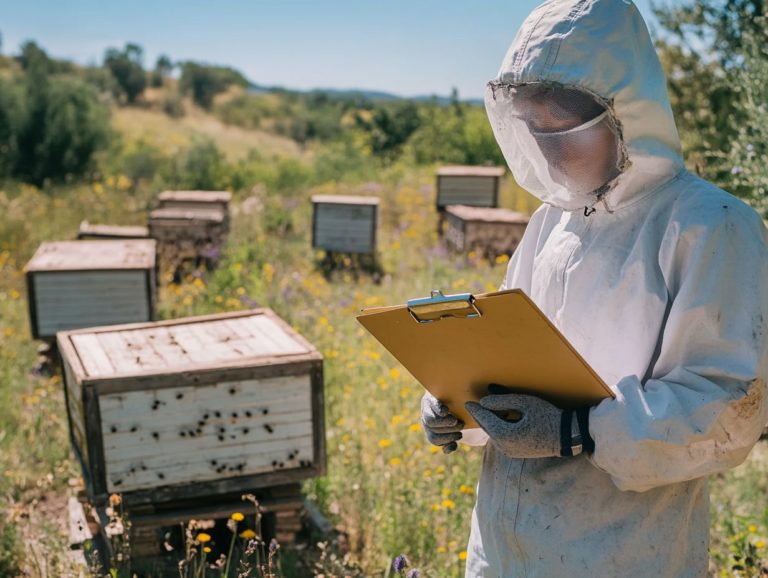Understanding Hive Dynamics
Get ready to explore the amazing world of hive dynamics! Grasping the intricacies of hive dynamics is crucial for both beginners and seasoned apiarists alike. This exploration sheds light on the complex social structure of a hive and the essential roles of the queen, worker, and drone bees. Discover the fascinating methods these insects use to communicate and cooperate.
The study of hive dynamics often involves concepts from the study of how groups behave in nature. You will discover the myriad factors that impact hive health and productivity. A deeper understanding of these dynamics can enhance your honey production and elevate your beekeeping practices.
This includes understanding how density fluctuations and mutual interactions within the hive can lead to properties that optimize the colony’s efficiency. Embark on this journey with us as we unveil the secrets of these extraordinary insects!
Don’t miss out on these insights that can dramatically boost your honey production!
Contents
Key Takeaways:
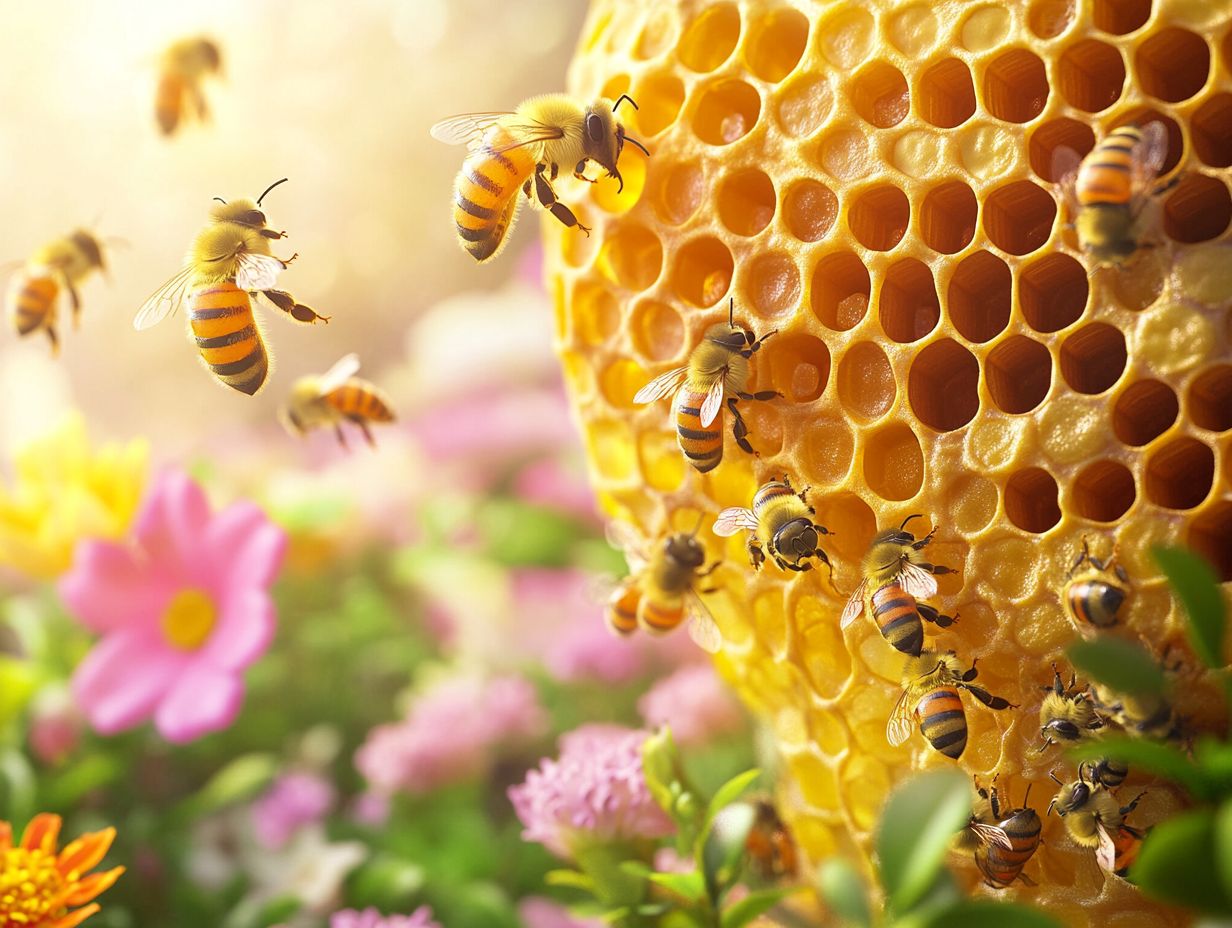
- Understanding the different types of bees in a hive can help beekeepers better manage their hives and maintain a healthy colony.
- Hive dynamics are influenced by seasonal changes, food availability, and the presence of pests and diseases like Varroa mites, Nosema, and American foulbrood. This makes it important for beekeepers to monitor and address these factors.
- By understanding hive dynamics, beekeepers can improve honey production, detect issues early on, and implement more effective and sustainable beekeeping practices.
What is a Hive?
A hive represents a remarkable structure where social insects, especially honeybees, coexist and engage in vital activities. It functions as a communal habitat that fosters the complex dynamics of hive life, characterized by distinct roles such as the queen bee, worker bees, and drones.
Research by scientists like Gernat and Wilson has shown how these dynamics resemble behavioral structures seen in other species, such as foraging ants. Each of these roles is integral to the survival and efficiency of their society.
Within the hive, the interactions and density of honeybee occupancy play a crucial role in shaping collective behavior. This allows for the emergence of properties that are essential for the sustainability and overall health of the hive.
The hive often operates at an optimal density, similar to self-adjusted states seen in systems studied in the context of group behavior.
What are the Different Types of Bees in a Hive?
In a typical hive, you will encounter three primary types of bees: the queen bee, worker bees, and drones. Each type fulfills distinct yet interdependent roles that are essential to maintaining the hive’s functionality and stability.
The queen bee, as the sole reproductive female, takes on the crucial role of egg-laying. She ensures the continuity of the colony while producing pheromones that shape the hive’s social structure and influence worker behavior.
These chemical signals are fundamental in maintaining harmony within the colony. Worker bees perform many tasks, from foraging for nectar and pollen to nursing the young and maintaining the hive.
This includes producing bee bread, a nutritious food for larvae. Drones, in contrast, exist primarily for reproduction, underscoring the intricate social structure of bee society.
1. Queen Bee
The queen bee stands at the heart of the hive, serving as the essential reproductive figure. She is crucial for sustaining the colony’s population and genetic diversity.
Her presence is vital; she lays thousands of eggs each day. However, her role doesn’t stop there. She also produces pheromones that shape the hive’s social structure and influence worker behavior.
The interaction between the queen and her worker bees is characterized by a sophisticated communication system. This ensures seamless cooperation among all hive members.
Without her, the organization of the hive can unravel, leading to diminished productivity and a weakened community. Thus, the queen’s influence extends well beyond mere reproduction; she is the linchpin that binds the hive together.
2. Worker Bees
Worker bees serve as the backbone of the hive. They forage for food, maintain the hive s structure, and care for the brood (the young bees). Their efforts exemplify the remarkable collective dynamics that sustain the entire colony.
These industrious creatures are always on the move, collecting nectar and pollen essential for the community’s nourishment. They also meticulously clean the hive, tend to the queen, and regulate temperature by fanning their wings. Isn’t it fascinating that fluctuations in hive density can significantly impact how many bees are available for these various tasks at any moment?
During peak foraging seasons, as the population surges, worker bees often shift from brood care to food collection to meet increasing demands. This highlights their adaptability and the intricate balance required for effective hive maintenance.
3. Drone Bees
Drone bees occupy a specialized role within the hive. Their primary focus is reproduction through mating with the queen during her mating flight.
These male bees, which lack stingers, do not engage in foraging or hive maintenance. They emerge from unfertilized eggs and experience a life of relative ease, but their existence is tied to the queen s reproductive activities. Their interactions with her are crucial; during fleeting mating flights, they compete fiercely for the chance to mate, ensuring genetic diversity within the colony.
However, their role has an expiry date. After mating, their lives end abruptly, emphasizing the limited nature of their existence in the hive s ecosystem. They exist solely to ensure the continuation of the next generation, embodying the singular mission of their brief lives.
How Does a Hive Work?
A hive functions through a sophisticated interplay of roles among its residents. The queen bee and worker bees collaborate to ensure the colony operates smoothly and adapts to changing conditions.
The queen bee takes charge of reproduction, while the worker bees handle foraging, brood care, and hive maintenance. This mutual interaction shapes the dynamics of the hive. Such balanced cooperation leads to an optimal density of bees, which is vital for maintaining the health and productivity of the hive.
1. The Role of the Queen Bee
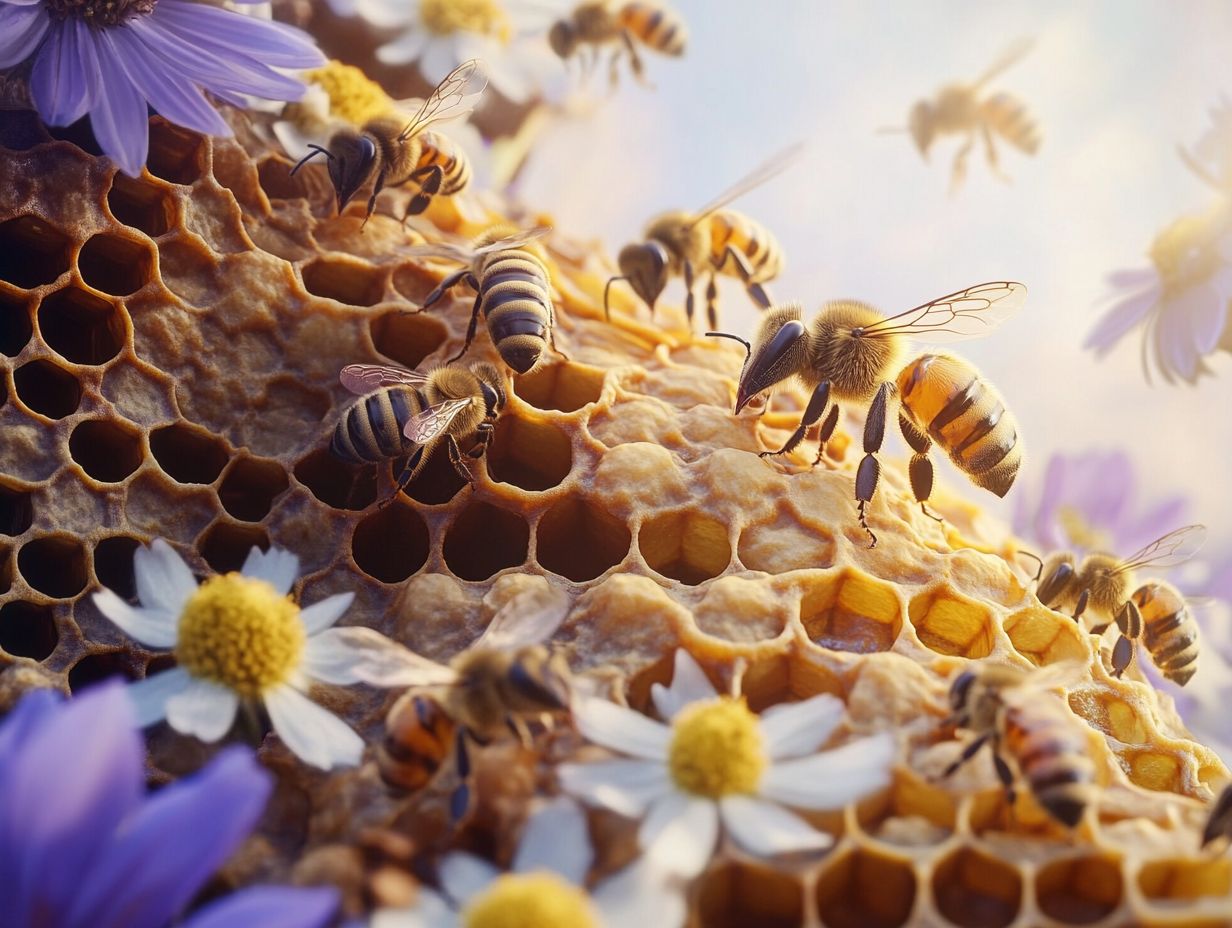
The queen bee s primary role in the hive is crucial she ensures the continuity of the colony through her consistent egg-laying, a fundamental aspect of maintaining a robust population.
Think of her as the heart of the hive, generating a rhythm that directs the worker bees in their tasks. By laying thousands of eggs each day, she replenishes the ranks of the worker bees and manages the hive’s genetic diversity through selective mating with drones. This bolsters the colony’s resilience against disease.
Her pheromones are pivotal in shaping the dynamics within the hive. They cultivate harmony among the workers and stimulate their nursing behaviors. In times of crisis, she adeptly shifts her laying patterns to prioritize creating new drones or workers. This demonstrates her remarkable adaptability and profound connection to the overall health of the colony.
In conclusion, the hive’s system relies on the interconnectedness of its residents, each playing a vital role in maintaining the colony’s survival. To learn more about bees and support their conservation, consider getting involved in local beekeeping initiatives.
2. The Role of Worker Bees
Worker bees play a crucial role in the smooth running of the hive. They engage in various tasks essential for the colony’s survival. You might find them foraging for nectar and pollen, caring for the brood, or performing hive maintenance. All these activities are vital for keeping everything running smoothly.
These industrious insects showcase a remarkable division of labor. For example, some worker bees gather food resources, bravely venturing out to collect nectar and pollen from blooming flowers. This provides essential nutrients for the colony. Others nurture the young by feeding larvae a special food called royal jelly and pollen, which helps them grow.
In addition to these tasks, worker bees maintain the hive’s cleanliness and regulate its temperature. They craft an optimal environment for development. These tasks connect the bees, helping them work together effectively and highlighting the significance of each worker’s contribution to the overall health and productivity of the colony.
3. The Role of Drone Bees
The role of drone bees is primarily about reproduction. They exist to mate with the queen bee, which is crucial for ensuring genetic diversity and continuity in the hive. This process is vital for maintaining the colony’s genetic health, much like the role of genetic variation in other communal species.
Drones are typically born in late spring or early summer. You can easily recognize them by their larger bodies and absence of stingers. Unlike worker bees, who handle various responsibilities, drones have a singular focus: to unite with the queen during her mating flight. This event is essential for the hive’s survival, as it guarantees that the queen produces fertilized eggs. This ultimately fosters a healthier colony.
After fulfilling this purpose, drones often meet their end shortly thereafter. Their lifecycle and interactions not only support the queen’s reproductive cycles but also influence overall hive dynamics, affecting all members and enhancing resilience in an ever-changing environment.
What are the Factors that Affect Hive Dynamics?
Several factors significantly impact hive dynamics, including seasonal changes, food availability, and the presence of pests and diseases. Each factor plays a crucial role in the overall health and productivity of the colony. Studying these factors involves examining the hive’s occupancy density and mutual interactions.
These elements influence hive behaviors and interactions among honeybees, ultimately affecting the stability and sustainability of the hive environment. Understanding these factors is essential for maintaining a thriving bee colony.
1. Seasonal Changes
Seasonal changes greatly influence hive dynamics. They shape resource availability and guide bee behavior in foraging and brood production.
In spring, as flowers bloom and temperatures rise, you ll notice a remarkable surge in bee activity! This is when they enthusiastically gather nectar and pollen, both essential for sustaining the hive. The abundance of resources allows for an increase in brood production, crucial for expanding the colony.
When summer arrives, foraging peaks, but challenges also emerge. Bees must contend with the heat and ensure they have access to water.
As autumn comes, the hive prepares for winter. Foraging patterns change as flowers dwindle, prompting bees to store resources vigorously. Winter brings dormancy, affecting the hive’s overall health. Bees cluster together to maintain warmth, but this can pose a risk if food reserves run low.
Understanding these seasonal variations is essential for effective hive management. Monitor your hives closely during these transitions to ensure the well-being of your bees throughout the year!
2. Food Availability
Food availability plays a crucial role in shaping hive dynamics. It directly impacts foraging activities, brood health, and the overall productivity of your honeybee colony.
When nectar flows are abundant, your foraging worker bees truly thrive. They actively seek out a diverse array of floral sources, collecting the sweet liquid that is essential for honey production. This bounty not only sustains the hive but also nurtures the development of larvae, paving the way for a vibrant future generation.
During seasons of floral scarcity, your foragers face significant challenges. Increased competition for resources can alter their foraging strategies as they adapt to dwindling supplies. In these trying times, worker bees may shift their focus from productivity to survival, changing their behavior in response to the scarcity.
In severe cases, prolonged food shortages can lead to colony stress, disrupting the social structure and triggering a decline in hive health potentially even resulting in abandonment.
3. Pests and Diseases
The presence of pests and diseases like Varroa mite and Nosema can severely disrupt your hive dynamics. They can lead to diminished bee populations and compromised hive health, which poses significant challenges to the survival of your colony.
These threats can manifest in various ways, impacting not only the health of individual bees but also their collective behavior. Take the Varroa mite, for instance a notorious parasite that latches onto honeybees and feeds on their bodily fluids. This leads to significant stress and weakens the bees’ immune systems, resulting in mismanaged foraging patterns and decreased reproductive capabilities among the hive members.
Similarly, Nosema, a microscopic fungus, can cause dysentery in bees, diminishing their ability to thrive and effectively communicate within the colony. The impact of Nosema on hive health can be as severe as American foulbrood, necessitating vigilant monitoring.
More severe threats like American foulbrood, a highly contagious bacterial disease, can lead to the complete collapse of your hive if not addressed promptly. It robs bees of their ability to maintain healthy brood development.
These dynamics underscore the importance of vigilant monitoring and proactive management to ensure the well-being of your entire colony.
How Do Bees Communicate within a Hive?
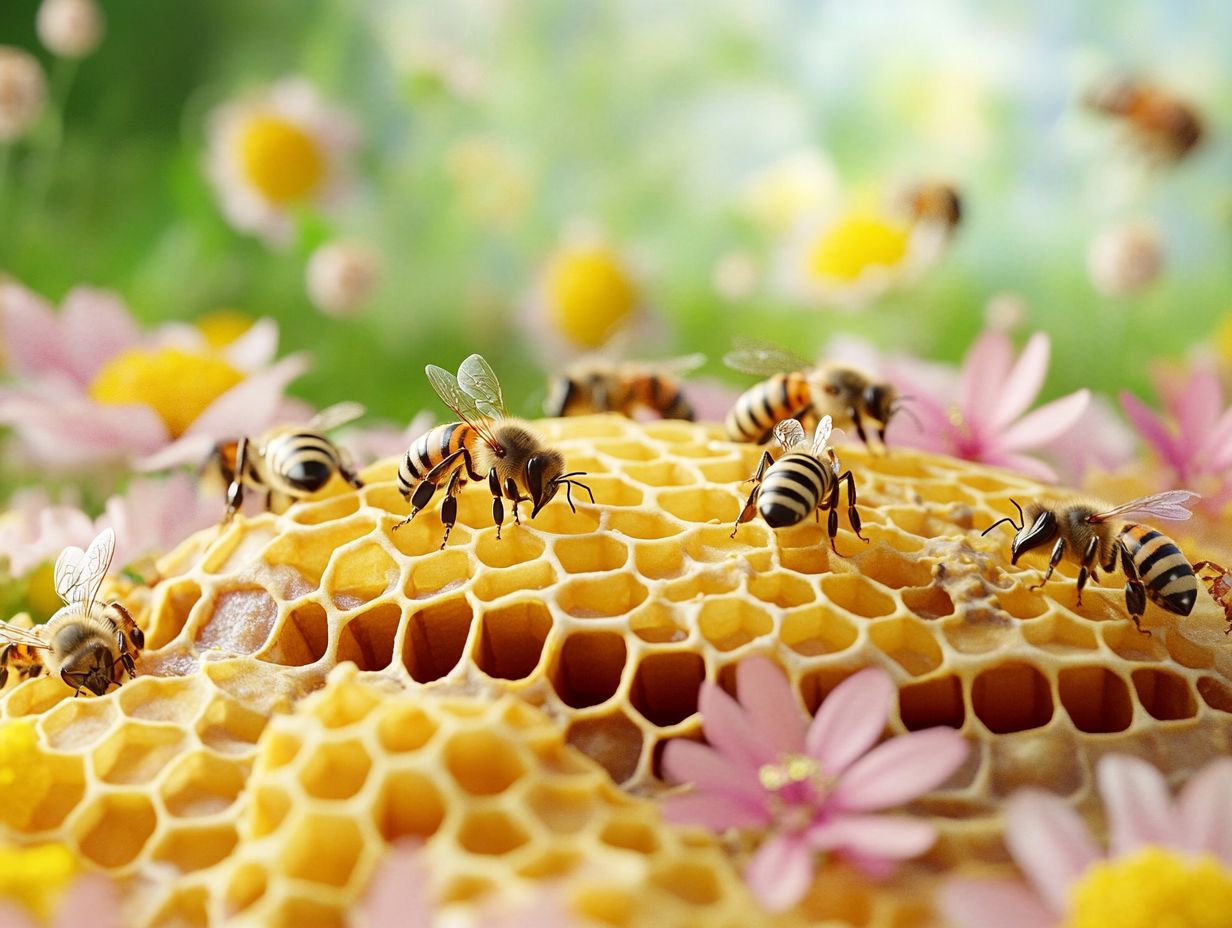
You ll find that bees utilize remarkably sophisticated communication methods within their hive. Their primary tools the waggle dance and pheromones enable seamless interactions among colony members and significantly enhance the dynamics of the hive.
These intricate communication strategies are essential for effective foraging, efficient resource sharing, and fostering overall cohesion within the colony.
1. The Waggle Dance and Polarization
The waggle dance is a fascinating communication behavior displayed by honeybees. It conveys vital information about the direction and distance of food sources, playing a crucial role in their foraging efficiency.
It works like polarization, which means when bees work together, they can find food sources more effectively. This remarkable behavior involves a series of rhythmic movements where a forager bee performs a figure-eight pattern, highlighting the ‘waggle‘ run. Similar to the Ising model in physics, the collective behavior of bees during the waggle dance illustrates how local interactions can result in global patterns.
This run indicates both the angle relative to the sun and the quality of the resource. These intricate movements are not mere theatrics; they enhance hive dynamics by ensuring that worker bees are synchronized in their foraging efforts.
By accurately transmitting these details, they cultivate a cooperative environment that reduces the time spent searching for food and boosts the overall productivity of the colony.
This collective intelligence demonstrates how mutual interactions among worker bees can lead to successful foraging trips, ultimately strengthening the hive’s prospects for survival.
2. Pheromones
Pheromones are the fascinating chemical signals that honeybees use to communicate within their hive, performing an array of functions such as marking trails, signaling danger, and indicating the presence of the queen bee.
These intricate chemical signals are crucial for maintaining the social structure and efficiency of the colony. For example, alarm pheromones serve as a warning, alerting other bees to potential threats and prompting them to defend the hive. The queen bee produces specific pheromones that foster cohesion among the workers while suppressing ovary development, ensuring a streamlined hierarchy within the colony. As foraging workers, they also emit pheromones that guide their fellow bees to abundant food sources.
Through these essential interactions, pheromones not only enhance cooperative behaviors among the bees but also sustain the overall harmony and productivity of the hive.
What are the Benefits of Understanding Hive Dynamics?
Grasping the intricacies of hive dynamics provides you with a wealth of advantages. It not only leads to improved honey production but also equips you with the ability to detect potential issues within the colony at an early stage. Researchers like Gernat and Wilson have contributed significantly to our understanding of these complex interactions.
By deepening your understanding of the complex relationships and behaviors among honeybees, you can adopt refined beekeeping practices that significantly enhance the health of the hive. This insight gives you the power to implement effective management strategies, fostering a thriving bee society and creating optimal conditions for your hives to flourish.
1. Better Honey Production
A deeper understanding of hive dynamics can significantly enhance your honey production, allowing you to create the optimal conditions that foster the health and productivity of your colony.
By gaining insights into the behavioral patterns and social structures within your hive, including the concept of nearest neighbor interactions, you can make informed decisions that promote efficient foraging and resource management.
For example, recognizing the signs of a queen’s productivity can indicate the right moment to introduce new supers for honey storage. Regular inspections enable you to spot potential issues, such as disease or insufficient space, allowing for timely interventions that can make all the difference.
Moreover, understanding how environmental factors influence bee activity helps you choose the best times for critical maneuvers like hive splitting or requeening. This strategic approach ultimately leads to enhanced yields and healthier bee populations, positioning you for success in your beekeeping endeavors.
2. Early Detection of Issues
Detecting issues within your hive early can drastically enhance the well-being of your colony, giving you the opportunity to tackle health concerns, pests, and diseases before they spiral out of control.
This proactive approach not only elevates hive dynamics but also cultivates a robust and thriving population of bees. By adopting regular monitoring strategies such as visual inspections, observing unusual behaviors, and assessing the condition of honey and brood you can spot early signs of distress.
Utilizing tools like varroa mite monitoring boards or temperature sensors can deliver invaluable insights into the health of your hive. Becoming familiar with the typical activities and patterns of your bees allows you to identify deviations that may indicate trouble, ensuring you can intervene promptly and create a sustainable environment for your colonies.
3. Improved Beekeeping Practices
Improved beekeeping practices arise from a profound understanding of hive dynamics, empowering you to make informed decisions that promote the health of your hive and boost honey production.
By recognizing how various factors such as temperature regulation, foraging patterns, Varroa mite infestations, and social hierarchies affect the colony s behavior, you can implement management strategies that significantly enhance overall colony health. This knowledge enables you to take timely actions, like adjusting hive placements or optimizing foraging conditions, fostering a more productive environment for your bees. For instance, researchers like Gernat have studied the effects of these factors extensively.
Understanding these dynamics helps create a thriving colony. It also reduces stressors and lowers the risk of diseases like Nosema and American foulbrood, increasing resilience against environmental challenges. As a result, you ll likely experience higher yields and improved honey quality, paving the way for sustainable beekeeping practices.
Frequently Asked Questions
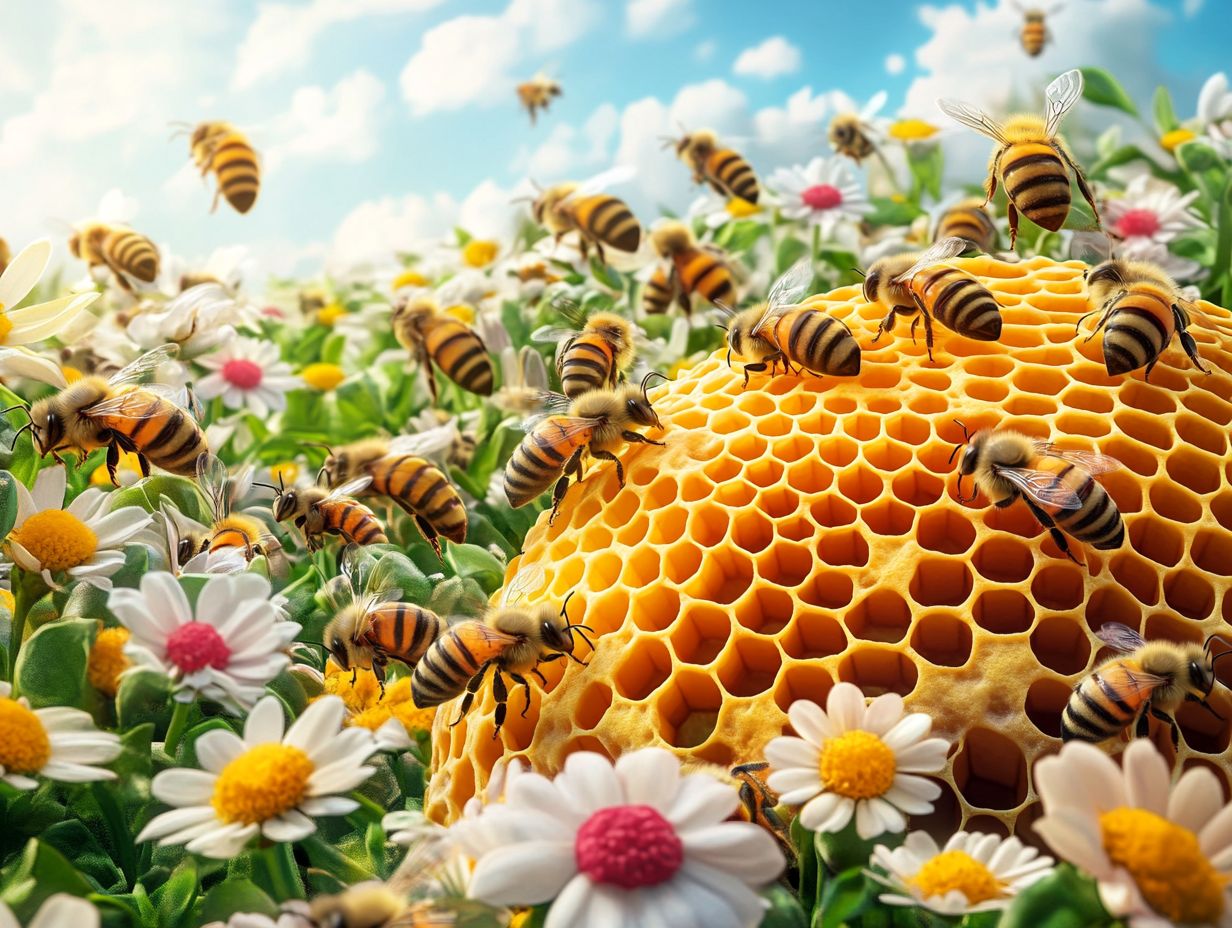
What is Hive Dynamics?
Hive Dynamics is about how bees interact and behave in a beehive, as well as how the hive works together.
Why is it important to understand Hive Dynamics?
Grasping Hive Dynamics is essential for every beekeeper eager to nurture healthy colonies! It also provides valuable insights into the social structure and communication of honeybees.
How do bees communicate within the hive?
Bees use a variety of methods to communicate within the hive, including chemical signals through pheromones, physical cues such as dancing, and auditory signals through buzzing and vibrations.
What factors influence Hive Dynamics?
The Ising model helps us understand the complex interactions within a hive. Hive Dynamics can be influenced by various factors such as the age, health, and genetic makeup of individual bees, as well as environmental conditions and the availability of resources.
How does the queen bee contribute to Hive Dynamics?
The queen bee is a key player in Hive Dynamics as she is responsible for laying eggs and maintaining the overall health and productivity of the hive. Her pheromones also regulate the behavior of other bees in the colony. Researchers like Wilson have highlighted the crucial role of the queen’s pheromones in hive stability.
Can Hive Dynamics be disrupted?
Yes, Hive Dynamics can be disrupted by various factors such as diseases, pests, pesticides, and human interference. It’s crucial to understand and manage these factors to maintain a healthy and thriving bee colony.
Start implementing these practices today and watch your bees thrive!

